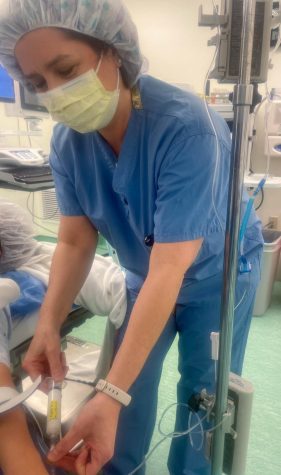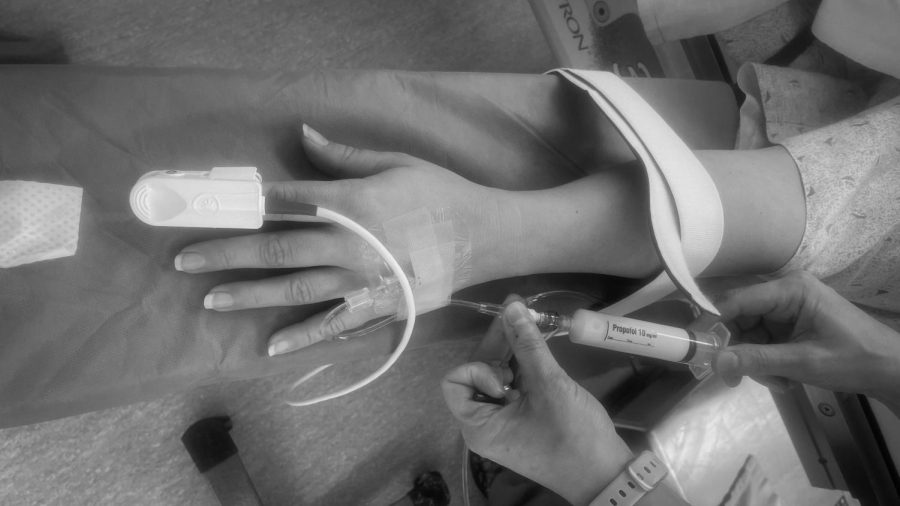Going Under
For surgery patients, going under anesthesia can be scary. For surgeons and Anesthetists, it’s just another day at the office.
March 8, 2023
Certified Registered Nurse Anesthetist (CRNA) Tammy Nuzzo has been a nurse anesthetist for 24 years and was previously a nurse for 4 and a half years. A nurse anesthetist is commonly confused with an anesthesiologist, but for good reason.
“A nurse anesthetist and anesthesiologist have very similar jobs, but very different ways to get to where they are. An anesthesiologist has 4 years of undergraduate college, followed by 4 years of medical school, then 3 years of residency and anesthesiology, with maybe a specialty with a fellowship in pain or cardiac. A nurse anesthetist however has 4 years of a nursing degree, but you could get a degree in biology and then go back and get a bachelor’s degree in nursing,” says Nuzzo.
Following nursing school you would need a minimum of 2 years of critical care experience. Then apply to an anesthesia school from anywhere from 28 months to 3 years, and then one final test called boards, if you pass that you’re all good. Boards are the SATs for medical trainees. These tests demonstrate that they are ready to take care of patients. [ It requires all this training because being a doctor is hard and extremely important to everybody else in the world. Doctors have one of the most important jobs in the world so this training is necessary.]
“The anesthesiologist figures out patient history, as well as what type of anesthesia might be used,” states Nuzzo, “The nurse anesthetist is there during the procedure, while the anesthesiologist is there before the surgery, and after in the recovery room,” Nuzzo continues.
What some people don’t know is all the types of anesthesia, which is surprisingly more complex than you might think. Sedation, otherwise known as twilight sleep, is what you might use if you get your wisdom teeth removed. Sedation is medication through an IV when you are breathing on your own and in and out of sleep.
General anesthesia is when the patient is unconscious and a machine would, in a way, breathe for you. Regional anesthesia is using nerve blocks- a good example of this is during childbirth. The woman will be completely numb, but completely wide awake. She won’t feel any pain at all- or at least that is the goal.
If you would work, let’s say, five days a week, you would probably average around two to four surgeries a week. Sometimes it might be a little different though, Muzzo explains that, “I can do anywhere up to twelve cases.” She later goes on to say, “I was in a lung room, and in eight hours I did two cases.”
One of the most well known surgeons in Pittsburgh, Thomas Krivak, was able to give some insights about what goes on behind the scenes of surgery. Krivak is Director Division of Gynecologic Oncology at Allegheny Health Network. He is also Director of the Ovarian Cancer Center of Excellence and Vice Chair for the Women’s Health Institute.
Preparations before surgery are looking “At patient’s history and physical to make sure and refresh your understanding of what medical conditions they may have, you need to prepare by doing their laboratory studies to look for abnormal laboratory studies that may trigger potential complications with the surgery. You also need to look at and review relevant CAT scans, MRIs, PET scans and things of that sort to make sure that you have a very good understanding of what the conditions may or may not be as well as procedures you may or may not need to do,” according to Krivak.

When it comes to what people don’t realize that goes on during surgery, he says, “Not a whole lot, I mean, I think patients are pretty well instructed about what happens during surgery, about getting anesthesia so they are placed under anesthesia and put to sleep. Most patients are actually paralyzed, they are given agents that paralyze them so their muscles don’t contract when we touch them. That’s to help control the ventilation.”
Krivak adds, “Some things that people don’t know is that sometimes surgeons will remove structures and go to pathology to look at a frozen section which is an immediate assessment to see if there is cancer present… it’s normally within 150 steps of the operating room, and patients aren’t left alone, there’s always other doctors in the room with them,” explains Krivak. He later goes on to say that about 25% of his surgeries he looks at frozen sections, and he normally averages about 40-45 surgeries a month.
NAI freshman Isaac Habineza shared what he remembers from his surgery recently, “The last thing I remember was getting anesthesia via the IV and they were wheeling me to the operating, next thing I know I’m in the recovery room feeling woozy and they were wheeling me out of the hospital into my car.”
For anyone preparing for surgery in the future, Habineza said he has “really no words of advice, just know that there is nothing to worry about.”













Tyler Reynolds • Mar 8, 2023 at 11:26 am
Nice Job Levi!!! God Bless you and keep you!!!!